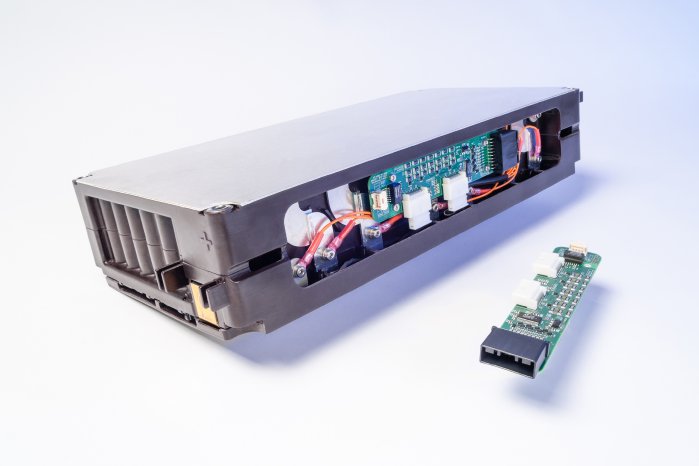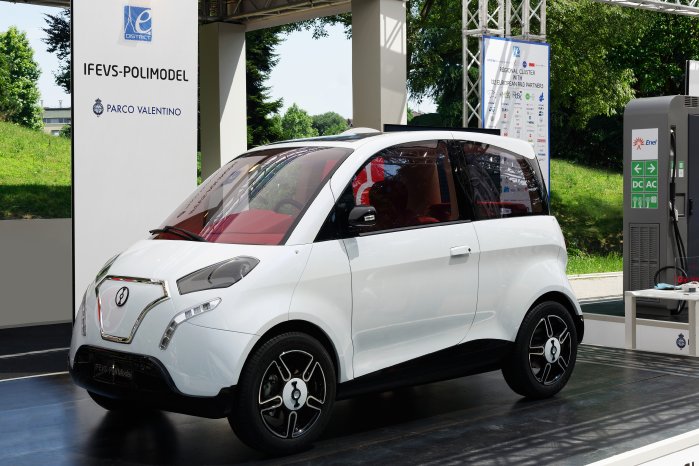During the European Project AVTR "Optimal Electrical Powertrain via Adaptable Voltage and Transmission Ratio" Fraunhofer IISB was responsible for the entire battery system of an electric vehicle (EV). In general, the Fraunhofer IISB Battery System Group focuses on innovative mechanical and thermal design of battery modules and systems including the related battery management system (BMS) with battery monitoring and the according battery models. The project has addressed the development and the industrialization of complete powertrain systems for light electric vehicles. In contrast to already available EVs, the international project consortium focused on a special electric vehicle that may fulfill the Japanese Kei-Car specification. The vehicle, developed by the Italian companies IFEVS and Polimodel, strictly follows four main objectives: low cost, modularity, producibility, and high-end Italian product design.
The vehicle is designed with a total length of approximately 3 meters, thus making the vehicle ideal for crowded inner-cities.
Being part of the international consortium, Fraunhofer IISB was responsible for the novel fully redundant battery system. The main objectives were attributed to the battery system, its battery management system, and battery monitoring.
The battery modules were designed in cooperation with the Dräxlmaier Group and manufactured by them. Highest modularity and independence of the battery cell manufacturer was achieved by using automotive grade 3 Ah cylindrical lithium-ion battery cells of type 18650 from an Asian battery manufacturer. Type 18650 battery cells are in highest mass production for years now, thus providing lowest costs, low manufacturing tolerances and are available from most premium cell manufacturers. The eight battery modules provide 12 kWh of energy to the 15 kW powertrain (30 kW peak power). The modules use a 20p7s cell configuration and bring a weight of only 9.4 kg, thus providing a gravimetric energy density on battery module level (i.e., with electronics included) as high as 160 Wh/kg.
Furthermore, battery monitoring placed on battery modules followed the same objectives. Battery monitoring was optimized for lowest size and bill of materials. The PCB size could be reduced to only 47 cm², still providing best voltage measurement accuracy, temperature sensing and passive balancing. The small size could be realized by using a highly integrated state-of-the-art battery monitoring IC with highest voltage measurement accuracy. Panasonic developed and provided novel prototypes of MOSFETs including protective elements for passive battery cell balancing. By using these novel MOSFETs, the bill of materials can be drastically reduced with positive effects on costs and reliability.
Finally, an advanced battery management system developed by Fraunhofer IISB and based on an Infineon 32 bit microcontroller running an automotive OSEK / Autosar operating system was adapted to the needs of the AVTR project and integrated into the battery system. The BMS comprises control algorithms (e.g., power contactor control), data communication via CAN bus, and advanced safety mechanisms for protecting the battery system. This BMS was integrated into both battery systems and configured to work as independent systems. As full redundancy was implemented, the driver of the EV is able to check the state of every battery system on the dashboard and even driving with only one axle is possible at any time.
With the vehicle developed within the AVTR project, highest modularity besides low costs and reduced complexity were implemented and shown for the first time together with stylish Italian car design. The shown concepts and prototypes prove the feasibility of a light full electric vehicle with reduced complexity, reduced costs and improved modularity. This development may lead to affordable EVs, thus increasing the attractiveness of EVs for the mass market.
The final presentation of the vehicle prototype took place during the unique Parco Valentino car show along with all European Premium carmakers in June 2015 in Turin, Italy. The AVTR project has received funding from the European Union’s Seventh Framework Program for research, technological development, and demonstration under grant agreement no 314128.



